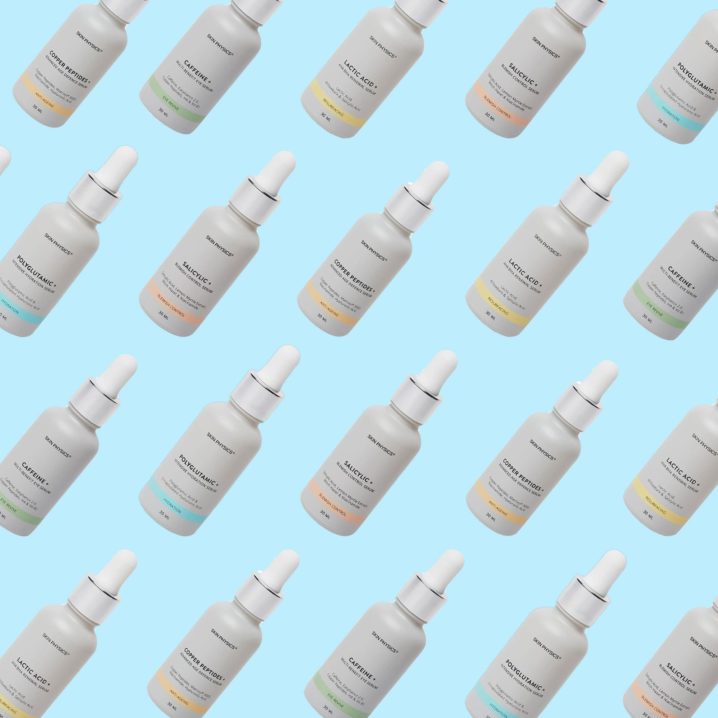
- POPSUGAR Australia
- Beauty
- The Best Serum for Every Skin Concern, According to a Dermatologist
The Best Serum for Every Skin Concern, According to a Dermatologist



POPSUGAR Australia has partnered with Skin Physics to help you find the right serum for your skin.
Wading through the crowded sea of serums can be tricky. For every skin concern, there are hundreds of products that promise to tackle that specific issue — and they might! But figuring out exactly what your skin needs to live its best life can feel like a mountain that’s not worth climbing. We’re here to tell you that it can be, you just need to find the right products for your routine.
It’s our belief that the key to choosing the right serum for your skin type is having a basic understanding of what some of the key ingredients actually do, so you can look out for them the next time you hit the shops to find your new holy grail product.
To help you do this, we’ve partnered with Skin Physics — a brand known for creating hyper-targeted formulations that are gentle and, most importantly, efficacious. Keep on scrolling to read our breakdown of the most common ingredients you’ll find in serums and to help you find the right serum for you and your skin concerns.
Dry and Dehydrated Skin
If you’ve spent any amount of time researching which serums are right for your dry, dull, or dehydrated skin, you’ve probably come across ingredients like hyaluronic acid or its sophisticated big sister, polyglutamic acid. Both are known for holding water inside your skin and making it look more juicy and plump and are ideal for people with these skin types.
Hyaluronic Acid
Over the past few years, hyaluronic acid has become one of the most well-known skincare ingredients, for its ability to hold water and, therefore, plump up the skin, support the skin barrier, and help to combat dehydrated skin.
The good news about hyaluronic acid is that (as Dr Shreya Andric, a Sydney-based dermatologist, confirms) you don’t necessarily need a specific, single-ingredient serum to get the benefits.
That means you can choose a serum with hyaluronic acid added in, or as part of a super-hydrating combination — with polyglutamic acid, for example, like in the Skin Physics Polyglutamic+ Intensive Hydration Serum — will be effective.
Polyglutamic Acid
The benefits of polyglutamic acid are similar to ingredients like hyaluronic acid and glycerin, Andric tells POPSUGAR Australia.
“When used in skincare, polyglutamic acid helps to draw moisture from the atmosphere into your skin, [meaning that] it is a humectant,” she says.
That means, not only does it help to increase the natural levels of hyaluronic acid in the skin, but it also helps to maintain it.
Acne-Prone Skin
Anyone with acne-prone skin will know the risks that come with introducing a new product into their skincare regimen.
Andric tells us there are a few ingredients you can look out for if you’re looking to add a new weapon to your acne-fighting arsenal without disrupting your skin. Namely, salicylic acid, witch hazel, and retinol.
Salicylic Acid
One of the most common ingredients used in acne-treatment skincare is salicylic acid, a beta-hydroxy acid (BHA).
“Salicylic acid is oil-soluble, which means it can go deep into your pores to clear them out — and because of this, BHAs are best used on oily or acne-prone skin,” she says.
She also adds that while its use in the treatment of acne is well-known, it can also reduce redness as well as inflammation, which are both common concerns for people who suffer from blemishes.
Witch Hazel
According to Andric, witch hazel has been used for many years as a soothing ingredient in skin toners, cleansers, wipes, and other skincare products.
“It has antioxidant, astringent, and anti-inflammatory properties and can be (and has been) used for many different skin concerns,” she says.
“There is some evidence it may be helpful in reducing itch and improving redness and scaliness associated with eczema and can also soothe inflamed acne.”
Witch hazel is best used in formulated products like the Skin Physics Salicylic Acid+ Blemish Control Serum (rather than buying straight witch hazel extract from the chemist) and toners to ensure your skin is getting the right concentration for your skincare concern.
Retinol
Aside from sunscreen, retinol and retinoids have the most evidence to back their efficacy than any other skincare ingredient, says Andric.
A derivative of vitamin A, retinol is a powerhouse skincare ingredient, and, when used correctly, it can treat acne, help to fade post-acne scarring and melasma.
Sun Damage and Wrinkles
The term “anti-ageing” can sound negative, but really all it means is that you’re choosing products that will maintain the bright plumpness of youthful skin, maintain skin elasticity, and keep it glowing for years to come.
Whether that means buying serums that contain ingredients that fill out fine lines or protect your skin from environmental aggressors like pollution and the sun, it’s just about future-proofing your skin, if it’s a concern for you.
Copper Peptides
Andric explains that peptides are naturally occurring amino acids that can help in the production of collagen and elastin, which are responsible for smooth, firm skin.
“Copper peptides, specifically, have been found to reduce the appearance of wrinkles, even skin tone, and have antioxidant effects,” she says. That’s exactly why Skin Physics has made it the hero ingredient in the Skin Physics Copper Peptides+ Advanced Age Defence Serum.
Retinol
Like we mentioned earlier, retinol and retinoids have a lot of scientific evidence to back up their efficacy most evidence backing their efficacy in treating acne and melasma — and the same is true for anti-ageing.
“[They] are also effective in reducing fine lines, freckles, acne scarring, and sunspots when used for longer than six months,” says Andric.
You don’t necessarily need this to be included in your serum step but is a nice add-on.
Lacklustre Complexion
Resurfacing is really a fancy way of saying exfoliation. But before you go picturing abrasive scrubs that could cause more hurt than good, let us introduce you to a couple of resurfacing ingredients that’ll help you slough away dry and dead skin cells to reveal a smoother and more even complexion underneath.
It’s worth noting that, when used correctly, resurfacing serums can help clear mild congestion, too.
Lactic Acid
Lactic acid is an alpha-hydroxy acid (AHA) that’s derived from milk and, in skincare, it works as a chemical exfoliator (as opposed to a mechanical or physical exfoliator).
“Consistent use of lactic acid increases cell turnover, resulting in a smoother, less scaly surface,” says Andric.
“It can help with dry skin, acne, keratosis pilaris, as well as [reducing the appearance of] sunspots.”
Salicylic Acid
As mentioned previously, salicylic acid is a common BHA used in products designed to treat acne, but that’s not all it’s good for. Since lactic acid is a chemical exfoliator, it helps to increase the rate of your skin’s natural cell turnover, thus decongesting and refining pores.
Andric advises that BHAs are best for acne-prone skin, while AHAs are best for all other skin types. If you’re using a product that combines both (which many people prefer), start slowly by using the product once or twice a week and build up the frequency from there. A great option is the Skin Physics Lactic Acid+ AHA BHA Renewal Serum, which combines lactic and salicylic acids with calming willowbark extract.
Under-Eye Puffiness
If you regularly wake up with puffiness around the eye, there’s one ingredient that could help to brighten and tighten the area up: caffeine.
Caffeine
Caffeine has antioxidant properties and, when added to eye serums, can decrease under-eye puffiness and the appearance of dark circles.
“It has the ability to constrict the blood vessels, which is what makes it a useful ingredient in eye creams when trying to reduce puffiness,” explains Andric. We firmly believe that a lightweight eye serum like the Skin Physics Caffeine+ Multi-Benefit Eye Serum feels luxurious, but still sinks into the skin while it wakes up your eye area.
Just Needs a Little TLC
Serums are generally accepted to be the step in your skincare routine that’s worth investing in — in short, it’s where you’ll get the most pay-off for handing over a slice of your hard-earned paycheck.
But amongst the bold ingredients that tackle very specific skincare concerns, there’s one hard-working ingredient that pops up again and again as a good all-rounder. That ingredient is niacinamide.
Niacinamide
Just like hyaluronic acid, you don’t necessarily need a niacinamide-specific serum, but when it’s already added to another serum you’re considering, there are many quiet benefits you’ll be rewarded with.
“Niacinamide is a form of vitamin B3 and, when taken orally, it has been found to reduce the number of skin cancers developed in patients who are prone to them,” explains Andric.
It also has numerous benefits when used topically, including:
- Improving the skin barrier
- Minimising redness
- Minimising pore appearance
- Regulating oil production
- Protecting against sun damage
- Reducing pigmentation
- Minimising fine lines and wrinkles
- Protecting against oxidative stress
- Treating acne
When added to serums for blemish control and anti-ageing, for example, niacinamide can complement the more aggressive active ingredients by soothing irritation and inflammation. You’ll find niacinamide in both the anti-ageing and blemish control formulations in the Skin Physics range.
If you’re ready to find the right serum for your routine and skin concern, head to the Skin Physics website to explore their range of powerful and targeted serum formulations.

